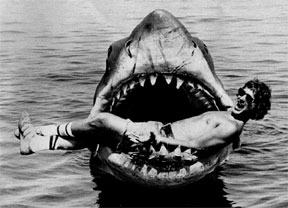Spielberg: 30 Years of Blockbusters part I

The 1975 release of Steven Spielberg’s Jaws coincided with the arrival of the New Hollywood, a golden age of American film production in which creative power transferred from studio heads to film directors. Despite being a product of this artistic flourish, Jaws represents several milestones in Hollywood business practices. By twisting its now legendary shooting fiascos into hype, saturating theaters through wide release, and expanding promotional advertising beyond traditional print and radio into television – an advertising medium still in its infancy – as well as commercial tie-ins, Universal Studios formed the archetype of blockbuster advertising out of Spielberg’s action/horror hybrid (Schatz 24). The resulting success not only set the precedent for current modes of movie marketing, but launched the career of director Steven Spielberg.
Thirty years later, Spielberg released War of the Worlds, a high octane special effects extravaganza based on the classic novel by H.G. Wells. LikeJaws before it, War of the Worlds served as summer popcorn fare, escapist cinema functioning solely to entertain, excite, and encompass audiences in the wizardry of special effects. Unlike Jaws, however, which was generally praised for being an effective thriller, War of the World met several detractors, dismissing it as one of Spielberg’s lesser films, a soul-less “exploitation of tragic iconography” (Stephen Whitty, Newark Star Ledger). What, if anything, about Spielberg’s cinematic approach differs between these two films? In analyzing the thematic and stylistic content of both Jaws and War of the Worlds, one notices that, though the formula remains the same, subtle disparities make a World of difference .
Before I begin to closely examine these films, it is necessary to explore the circumstances surrounding their individual productions. The production of Jaws revolved around a novice director, a cast of unknowns, and unreliable, untested special effects. Spielberg resisted casting any star power, acquiring actors whom he felt reinforced the realism of the story. According to a quote attributed to Spielberg in Peter Biskind’s Easy Riders, Raging Bulls, he “wanted somewhat anonymous actors to be in it so you would believe this was happening to people like you and me” (Biskind 265). Similarly, Spielberg’s visual aesthetic reinforced this idea of realism. Refusing to work within a studio, production moved to the open sea, where technical problems and production delays pushed the budget well beyond the initial projected $3.5 million. Ultimately, shooting went 104 days over schedule and nearly $7 million over budget (Biskind 267). Alternately, War of the Worlds quick production reflects a confident, assured director. Initially set for a 2007 release date, the film was abruptly green-lit in August 2004, and released summer 2005. Unlike with Jaws, the presence of megastar Tom Cruise was crucial to getting Worlds off the ground. Spielberg shot the film within four months on a gargantuan budget of over $132 million. Pre-publicity for the film focused on the large budget – an August 18th 2004 article on IMDB.com reported “Steven Spielberg's upcoming movie War of the Worlds is poised to make history in Hollywood as the most expensive film ever made - surpassing Titanic's $198 million budget... No expense will be sparred” – as well as the large profit Spielberg, Cruise, and the studios stood to make from the film’s success (imdb.com).
These two radically different productions reflect a director refocusing his priorities despite making similar movies. Spielberg’s budget problems and production delays onJaws rose out of the need to tell the story realistically and effectively. His choice to use unknown actors and real sets reinforced the blue-collar, everyman feel of the movie. Contrarily, Spielberg used budget and star power to the extreme while producing War of the Worlds. He ignored the stigma surrounding actor Tom Cruise, and focused his attention on the extravagance of effects, producing aesthetically different results.
Spielberg Part II Coming Soon!

No comments:
Post a Comment